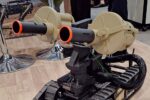The Association of the United States Army (AUSA) Annual Meeting 2025 showcased a wave of next-generation military technologies poised to redefine the U.S. Army’s operational edge. From AI-enhanced loitering munitions and counter-UAS systems to directed energy weapons and robotic combat vehicles, the event highlighted how industry is aligning with Army Futures Command’s modernization priorities.
AI-Enabled Loitering Munitions Take Center Stage
Among the most prominent trends at AUSA 2025 was the surge in AI-integrated loitering munitions designed for precision strike and autonomous target acquisition in contested environments. AeroVironment unveiled its upgraded Switchblade 600 Block 2 system featuring enhanced autonomy modules capable of onboard target recognition using electro-optical/infrared (EO/IR) fusion and machine learning algorithms.
Shield AI also presented its V-BAT teaming concept with loitering payloads that leverage Hivemind software for decentralized swarm coordination in GPS-denied environments. These developments reflect a broader shift toward manned-unmanned teaming (MUM-T) and attritable strike capabilities in Multi-Domain Operations (MDO).
Directed Energy Weapons Reach Tactical Maturity
Raytheon Technologies and Lockheed Martin both demonstrated advancements in high-energy laser (HEL) systems aimed at short-range air defense (SHORAD) roles. The Army’s Directed Energy Maneuver-Short Range Air Defense (DE M-SHORAD), based on a Stryker platform with a 50 kW-class laser from Lockheed Martin, is nearing initial fielding after successful FY2024 testing at White Sands Missile Range.
Boeing’s Compact Laser Weapon System (CLWS) Gen III was also on display with improved beam control and thermal management for mobile counter-UAS operations. These systems offer low-cost per shot engagement options against Group 1–3 drones, rockets, artillery, and mortars—critical for defending forward-deployed units under saturation attack scenarios.
Next-Gen Combat Vehicles Emphasize Modularity and Robotics
The Optionally Manned Fighting Vehicle (OMFV), part of the Army’s Next Generation Combat Vehicle portfolio replacing the M2 Bradley IFV, was a major highlight. General Dynamics Land Systems showcased its OMFV prototype featuring open architecture electronics compliant with CMOSS/MOSA standards and scalable armor packages.
Textron Systems presented an updated Ripsaw M5 robotic combat vehicle equipped with FLIR sensors and modular payload bays for EW or kinetic effectors. The vehicle supports remote operation via tethered drone overwatch or autonomous waypoint navigation—key enablers for reconnaissance-in-force missions without risking crewed platforms.
Hypersonic Weapon Integration Progresses
The Long Range Hypersonic Weapon (LRHW), developed under the Army’s Strategic Fires program in partnership with Dynetics and Lockheed Martin, was featured as it approaches Limited User Testing in early 2026. The weapon uses a Common Hypersonic Glide Body atop a two-stage booster stack capable of Mach 5+ speeds over ranges exceeding 2,775 km.
A key focus at AUSA was integration into mobile ground launchers such as the Typhon system—a trailer-based platform derived from MK41 VLS components adapted for land use. This aligns with Indo-Pacific posture shifts emphasizing distributed fires across archipelagic terrain.
Advanced Counter-UAS Systems Expand Coverage
The proliferation of small drones on modern battlefields has prompted rapid development in layered counter-UAS solutions combining kinetic interceptors, jamming systems, and directed energy. Anduril Industries displayed its Lattice OS-powered CUAS suite integrating radar cuing with AI-based threat classification across multiple sensor feeds.
Sierra Nevada Corporation introduced an expeditionary version of its X-MADIS system optimized for rapid deployment on JLTVs or MRAPs. It combines EO/IR tracking with RF detection/jamming to neutralize drone threats autonomously or via operator-in-the-loop control loops—vital for maneuver units operating beyond fixed base defenses.
Tactical Communications & C4ISR Modernization
L3Harris Technologies highlighted advances in resilient tactical communications under Capability Set ’25 initiatives including resilient mesh networking radios supporting SATCOM fallback modes and Link-16 interoperability across joint platforms.
The Integrated Tactical Network (ITN) architecture continues to evolve toward greater modularity using Nett Warrior-compatible handhelds paired with secure Android Tactical Assault Kits (ATAK). These upgrades support Joint All-Domain Command & Control (JADC2) goals by enabling faster sensor-to-shooter loops across echelons.
Energy Resilience & Sustainment Solutions Gain Traction
A growing emphasis on expeditionary sustainment led to several innovations in energy storage and power management. GM Defense showcased its all-electric Infantry Squad Vehicle variant powered by Ultium batteries offering reduced acoustic signature and simplified logistics tail compared to diesel counterparts.
Rolls-Royce LibertyWorks presented microgrid-ready generator sets optimized for hybrid power architectures supporting both vehicle recharge stations and forward command posts—crucial for extended operations where fuel resupply is contested or denied.
AUSA Signals Doctrinal Shift Toward Multi-Domain Dominance
The cumulative theme across exhibits underscored a doctrinal pivot toward Multi-Domain Operations by 2030—requiring convergence of cyber-electromagnetic effects, long-range precision fires, unmanned teaming concepts, resilient comms architecture, and adaptive sustainment models under contested conditions.
This year’s AUSA served not only as a technology showcase but also as an indicator of procurement priorities shaped by lessons from Ukraine conflict dynamics—namely drone proliferation, EW battlespace saturation, logistics vulnerability under firepower dominance—and emerging threats from near-peer competitors like China in Indo-Pacific theaters.









